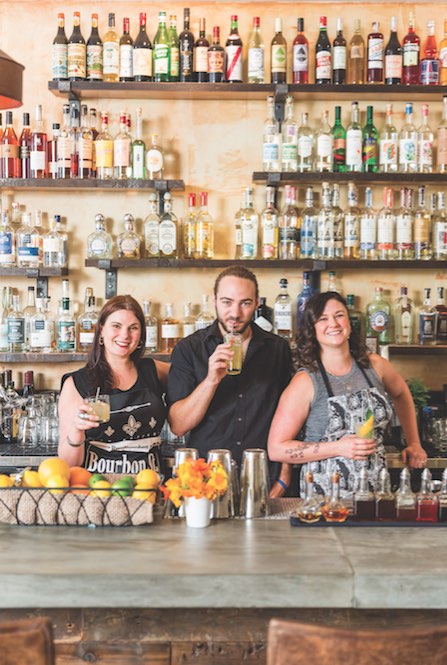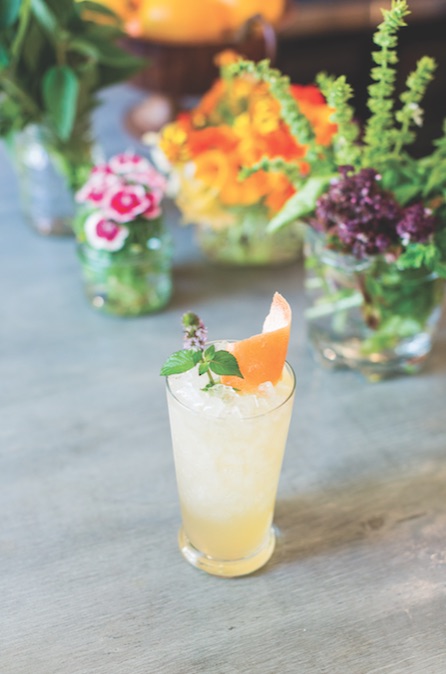Garden-to-glass drinks, joyfully crafted from homegrown ingredients, are on the rise.
When Tara Heffernon and her business partners Laura Sanfilippo and Steven Maduro decided to open their own bar, they wanted to create a welcoming, neighborhood watering hole in central Healdsburg.
“If you’re about to go to dinner at Vallette (a high-end local restaurant) and you’re dressed to the nines, we want you sitting next to someone in soil-covered Carthartt overalls who came in to get a beer before they go home—because they got up at five a.m. to work in the fields,” says Heffernon at Duke’s Spirited Cocktails, which opened in June. “We want all of those people in here.”
For a bar in a top wine country destination—which was once largely working class with prune and apricot orchards stretched out along the Dry Creek Valley before vineyards took over—the idea of a Healdsburg bar serving as a meeting place for a wide demographic is exciting and entirely appropriate.
Duke’s sits on Plaza Street, facing the town square in a historic building that first served as the small farming community’s general store in 1888. The first bar on the site arrived in 1933, followed by the Vic and Sip Bar in 1947. Much later, John & Zeke’s poured pints for locals before moving down the street to Healdsburg Ave. Sanfilippo points out the gel prints of historic photographs of the bar and neighboring buildings that hang on the walls—a design touch that ties the region’s agricultural roots to what the young, energetic, and creative trio have created in 2016.
“There are a lot of places where you can go and get interesting upscale cocktails, “ says Heffernon. “We’re also trying to maintain what bars have always been throughout history—a friendly neighborhood spot. We’re trying to not be that place that is intimidating or unapproachable or stuffy.”
The three have ample experience in the industry, most notably at Spoonbar, where Heffernon worked alongside industry mix master Scott Beattie during the restaurant’s opening in 2010. Heffernon, a 31-year-old Sonoma County native, also ran a bar and bartender consulting company. Originally from Oregon, Sanfilippo landed in San Francisco and later Sonoma County where she joined Heffernon at Spoonbar. Self-taught in mixing syrups and bitters for their drinks, the Duke’s team brings personal touches to every beverage that crosses the bar. It’s an aspect that sets them one step ahead in the emerging but crowded sea of farm-to-table—or, in this case, garden-to-glass—cocktails.
“When you see our cocktail menu and you see an herb or a fruit, 90 percent of it is from our own home,” says Heffernon, who lives in Forestville. “And if it’s not, we’re doing our damnedest to source it locally.” The list of ingredients that Heffernon and Sanfilippo grow for their cocktails is long: stone fruit, grapes, berries, a variety of basil and tarragon, 10 types of mint, pineapple sage, and edible flowers.
“Some of the flowers [are used] because they have great flavor, but also sometimes it’s nice to get a drink with a flower and say, ‘wow, that’s sexy!’” says Heffernon.
As we sit at the bar, Sanfilippo fills a glass with a drink from the tap, a Fine Line, one of Duke’s signature cocktails, an insanely delicious blend of Sonoma Brothers vodka, Guayaki, lemon verbena, and housemade nectarine tarragon bitters ($11).
“We can’t possibly plant enough lemon verbena,” says Heffernon about the drink’s popularity.
Heffernon and Sanfilippo harvest the fruit and the herbs from their home gardens, transporting them to the small kitchen at the back of Duke’s where they set about mixing syrups, bitters, clarified juices, shrubs, milk punches, and more. They’ve concocted plenty of palate-enticing cordials: plum and cardamom, cherry and allspice, and cantaloupe with Calabrian chili. They also make ginger beer, tonic, and a seltzer water rumored to be the best in town. The kitchen vibe is hardworking, festive, and do-it-yourself. Lots of blanching, blending, smelling, tasting, and making small, limited batches of syrups made from fresh fruits, some even brought in by customers.
“We’re really big fans of wild and reckless experimentation,” says Heffernon. “It is
joyful work.”
The bar also takes a seasonal approach to ingredients. Fall and winter drinks utilize spices, local apples, pumpkin, and long-season crops like melon. As the weather turns colder, patrons can expect to taste hints of carrot, beet and caraway in their beverages. Duke’s has six cocktails on tap and a specials menu that changes every few days based on what is seasonally available. Patrons can also create drinks to order, and the bar has an almost exclusively local wine list (they playfully call it “Boozy Grape Juice”) as well as a beer list that includes local favorite Henhouse Brewery’s Oyster Stout on tap and cans of Bud Light.
As for the boozy core of the cocktails themselves, Duke’s sources vodka and gin from local and Bay Area distilleries first, including Graton Distillery, Spirit Works, Anchor Distillery, Charbay, and Sun Cellars in San Francisco. That said, not everything is local. An abiding love for Amaro, vermouth, scotch, and Japanese whiskey means that international spirits are equally embraced at Duke’s, along with a pragmatic sourcing approach.
“We are really fortunate that we get to be localists, but guess where the good vermouth is?” says Heffernon. “Not from the U.S. There are a few great producers locally, and we do buy from them first, but we still want to get more from Italy for flights.”
One very local house favorite is the Root 116, made with Benham’s Sonoma Dry gin from Graton Distilling Company, apple, lager reduction, ginger, coriander, and lemon ($12). The pricing may seem steep, but it’s comparable to similar “artisanal” drinks in other local bars. Quite frankly, it’s a steal, considering the amount of energy invested into growing, harvesting, and preparing the ingredients during the staff’s “off hours.”
Other cocktail bar and restaurants in the area—Campo Fina in Healdsburg, Mario & John’s in Petaluma, and Sebastopol’s Ramen Gaijin, to name a few—also utilize fresh local ingredients in lieu of canned or bottled mixers.
At Campo Fina, for example, bartenders Sean Dal Colletto and Amanda Jones make their own simple syrups: basil habanero, cucumber, vanilla, and cinnamon honey. They also use ingredients like peaches from Dry Creek Valley and strawberries from Preston Farm, which are used to craft a house shrub. Jones even planted an edible flower garden for drink garnishes.
“It’s important that we have the freshest ingredients because we are doing high-quality craft cocktails,” says Jones. “People are paying for an amazing experience, and we provide this by giving them well thought-out cocktails with our best local ingredients.”
Ramen Gaijin is known for their handcrafted cocktails, too. Some popular drinks utilize pickled garnishes, local, seasonal shrubs, and gins from Spirit Works and Graton Distilling Company.
In a national cocktail bar industry that rakes in about $25 billion annually from alcohol sales alone, local ingredients have changed cocktail menus across the country. The truth is, sourcing local ingredients—or even better, having bartenders grow herbs and fruits themselves—is making an impact. Money returns to the local economy, small-scale farmers have added markets for their products, and the environmental impact of transporting produce is reduced since packaging is reused or not needed at all. In fact, Duke’s skips bottled seltzer and ginger beer altogether by creating their own and providing it on tap. Aside from all of the feel-good benefits to the local community, there is something satisfying about knowing that your already enjoyable happy hour cocktail involves locally distilled spirits and herbal potions handcrafted by the very same bartender pouring it into your glass.
Still, Heffernon and Sanfilippo cringe ever-so-slightly at the term “farm-to-table” and even more-so at the term “mixologist.”
“The snobbery that comes with our type of mixing is hard for us because we’re also the type of people that think honestly that the number one rule—if there was a rule, and there shouldn’t be—is if you want to drink it, it’s good and it’s okay,” says Heffernon.
“Mixologist has been inappropriately used and overused,” adds Sanfilippo.
Or, what if we threw out all of these terms? What if we went back to seeing bars as places where people can have a good time, meet with friends, and drink a few good drinks, be they fancy or salt-of-the-earth.
“We don’t want to use terms that make it sound like the pinky’s in the air,” says Heffernon. “If you want to come in here and drink a Bud Light and a shot of Jameson, awesome! Sweet! We love you—you’re our people.”


